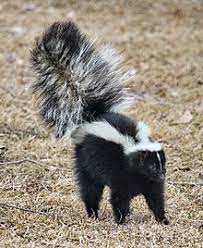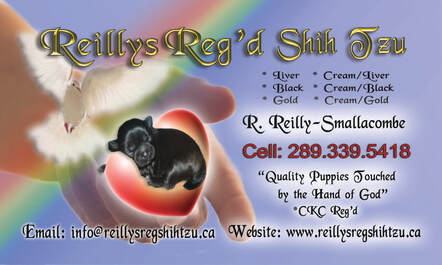 What to do when your dog gets sprayed by a skunk. Eileen Fatcheric, DVM When your dog gets sprayed by a skunk, there’s more to worry about than how to remove skunk smell from the dog. Although rare, compounds in skunk spray can cause chemical reactions in the body that damage red blood cells and hemoglobin. This can be deadly. While this reaction is least likely to happen if your dog is sprayed in open air, small dogs who get sprayed while trying to dig skunks out of burrows can collapse and lose consciousness so quickly that they must be dug out of the burrow themselves to be rescued. Hemoglobin damage occurs within minutes to hours. Signs include chocolate-colored gums, chocolate-colored urine, trouble breathing, weakness, collapse, seizure, and coma. Red blood cell damage may take three days to show up. Signs include weakness, lethargy, loss of appetite, and trouble breathing. So, the first thing to do when your dog gets sprayed by a skunk is to be aware of this rare but deadly consequence and carefully monitor your dog’s mucous membranes, urine, and breathing for several days after a skunk encounter. If you have any concerns, call your veterinarian immediately. On to how to remove skunk smell from your dog. Skunk smell can last on your dog and anything else it touches for up to three weeks! The sooner you begin to remove the smell, the better. The homemade recipe is the absolute best remedy for removing skunk odor from your dog. Nothing else comes close. Don’t waste time heading out to purchase commercial products while your dog stinks up your home. Keep these ingredients on hand at home, and you can be done with this smelly nightmare as fast as you can say “pee-yoooo.” Ingredients:
Remember that:
** Please note this is taken from Whole Dog Journal, One of my very favourite online dog magazines. To visit them and subscribe: Whole Dog Journal. Visit!
2 Comments
Excerpt from prouddogmom.com article:
I get recipes from Proud Dog's Website, and I love a lot of the articles. This one caught my eye because of the ingredients and fillers in the store bought treats that can have a huge impact on a dogs health. Long but worth the read. 10 Store-Bought Treats I Will Never Feed My Dogs: Proud Dog Mom Dangerous preservatives, questionable by-products, and cheap fillers … oh my! Have you ever read through the ingredient label of your store-bought dog treats? Many popular treats contain questionable – and downright dangerous – ingredients. This was something my family and I had no clue about until we had a couple of health scares and started digging into dog nutrition. I stopped feeding commercial dog treats about seven years ago and now exclusively bake homemade snacks for my furbabies. Red-Flag Ingredients to Avoid In Store-Bought TreatsBefore we dig into the list of store-bought treats I avoid, let’s take a look at some red-flag ingredients commonly found in dog food products. Artificial Preservitives
10 Store-Bought Treats I Will Never Feed My Dogs1. Milk Bones (Traditional Biscuits)For many people, traditional Milk Bones are the epitome of dog treats. They’re a well-known crunchy brown biscuit marketed as being “part of a healthy diet.” Yup, it says that right on the box. But, one look at the ingredient label and you’ll quickly realize there’s not one healthy thing about them. The first few ingredients: “Wheat flour, ground whole wheat flour, meat and bone meal, milk, beef fat (preserved with BHA/BHT and mixed tocopherols), …” Aside from the high wheat content (which I prefer to avoid), this list contains several of the red-flag ingredients I listed above. LATEST VIDEOSDIY Snuffle Mat Dog Toy Tutorial 2. Milk Bones Marrow SnacksThe Milk Bones brand is at it again with their marketing, saying these treats are, “Baked with love with colors from natural ingredients only.” Unfortunately, the ingredient label tells a different story. Red 40 and Yellow 5, which are two artificial dyes many pet nutrition experts warn against, are listed right on the ingredient label. That, along with wheat flour, meat and bone meal, sugar, poultry digest, BHA/BHT, salt, corn starch, malted barley flour, etc. 3. SnausagesHave you ever eaten pigs-in-a-blanket? You know, those mini hotdogs wrapped in dough? Well, Snausages dog treats look just like that. While they may look adorable, the ingredients are horrible. Soy flour, corn syrup, animal fat preserved with BHA, chicken by-product meal, artificial colors (Yellow 6, Yellow 5, and Red 40) and flavors … these are all ingredients listed on the Snausages label. Thank you, next! 4. Purina® Beggin’ Strips Dog TreatsYou’ve probably seen a bag of these treats before. They’re designed to look like bacon. And what dog doesn’t beg for a piece of bacon? Well, if you ask me, the only thing these treats should have you begging for is stricter guidelines in the dog food industry. Glycerin, sugar, corn gluten meal, and beef fat are just a few of the ingredients packed into these processed bites. 5. Pup-PeroniThese are beef-flavored pepperoni strips for dogs. And, just like the other treats featured on this list, they’re filled with ingredients such as meat by-products, sugar, onion extract, propylene glycol, and BHA. 6. Canine Carry Outs Beef Flavor Dog TreatsFrom their beef-flavored Steak Bites to their Beef and Bacon flavored treats, these snacks are glorified junk food for dogs. Corn syrup, soy flour, wheat flour, corn starch, and propylene glycol are some of the items found pretty high up on this long ingredient list. That’s not to mention BHA, which is used as a preservative, and artificial colors, such as Red 40. 7. Milo’s Kitchen Chicken MeatballsThe packaging for Milo’s Kitchen dog treats will fool you into thinking they’re a healthy bite. I actually used to buy these … before I started researching red-flag ingredients. The bag showcases a happy woman in the kitchen cooking for her dog – and a freshly cooked chicken breast sitting on the counter right next to her. But, one look at the ingredient label and you’ll realize these seemingly healthy treats are far from it. Along with cheap fillers and sugar, these chicken meatballs contain propylene glycol and onion extract. That’s a no for me. 8. Pup Corn® Dog TreatsA play on popcorn, the very first ingredient in these treats is corn flour. Not only is corn a cheap filler product with practically no nutritional value, but it’s also a known allergen. Canola oil and artificial colors also make an appearance on the ingredient list. 9. GreeniesThe first few ingredients in these teeth-cleaning treats are carbohydrates and glycerin. Guess what carbs do in the body? That’s right, they convert to sugar. And guess what glycerin is? That’s right, it’s a replacement for sugar. Last time I checked, sugar is not good for dental health! Sure, the unique texture may scrape against the teeth, but the ingredients are not ideal for dental health (or health, in general). If you’re in search of great dental cleaning aids, opt for a bully stick, let your pup play with toothbrush toys (designed to scrape against the teeth similar to a toothbrush), and work brushing into your dog’s daily routine. 10. RawhidesGive that good dog a bone! But wait … what kind? Sure, the image of a dog happily gnawing on a bright white rawhide bone may pop into your mind. But, think twice before tossing your dog a rawhide bone. First things first: These bones are loaded with chemicals, dyes, and glues. According to Dogs Naturally Magazine, “Once rawhide chews have been made, they’re preserved with various chemicals, which may include formaldehyde or chromium salts. When rawhide chews have been tested, they’ve shown things like lead, arsenic, mercury and other toxic metals as well.” Along with the chemicals, raw hides are linked to choking, airway obstruction, esophageal blockages, and intestinal blockages. Reilly's NOTE: For information on HOW rawhide is made, watch the video on our website. It is deadly! Think of the Long Term ImpactSome pet parents may argue these products are just treats. And, sure, treats aren’t supposed to be fed in large amounts. But, ask yourself: How many treats does your dog eat each day? Are they in the training phase where you’re doling out treat after treat for good behavior? Do they get one every time they come in from a potty break? Do they get one just for being cute? Long-term exposure to these red-flag preservatives and questionable/artificial ingredients can have an impact on our pups. And, when there are so many other options out there, I look at it this way: I would rather take the time to make my own treats or pay slightly more for a high-quality, single-ingredient dog treat than potentially pay more in vet bills down the road. |

 RSS Feed
RSS Feed